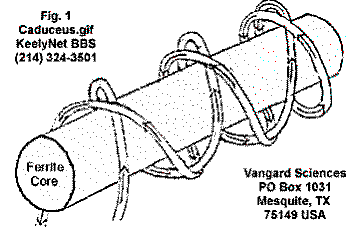This excellent file is courtesy of David Brenneman.
![]()
Certain experiments ... were carried out by independent researchers with caduceus-wound coils. This was also called a "Tensor" coil by its main proponent, Wilbert Smith.
The caduceus coil illustrated in Fig.1, basically consists of ordinary insulated copper wire wound in a double-helix around a ferrite core. THIS COIL HAS REPEATEDLY BEEN FOUND TO VIOLATE ESTABLISHED LAWS OF ELECTROMAGNETICS AND HERTZIAN WAVE THEORY WHEN A HIGH FREQUENCY CURRENT IS INJECTED INTO IT.

First. This apparatus has zero impedance - unlike an ordinary coil. when fed electrical energy the wire in the Tensor coil does not get hot.
Secondly. It has infinite resonance - unlike an ordinary coil which will resonate chiefly at its natural fundamental frequency and weakly on the second or third harmonic, the Tensor coil is capable of resonating strongly on any number of frequencies randomly spaced in the spectrum. The signal pumped into such a coil strangely enough cannot be quantified (detected) by standard RF (radio frequency) detection apparatus. Many "Ham" radio operators and electronic technicians who have used these coils, are completely baffled by them. One radio amateur found that with two such coils, one used as a transmitter and the other as a receiver, the second would not pick up the signal from the first unless they were precisely aligned.
For the signal to be transmitted the alignment had to be as critical as that of a laser beam.
![]()
CADUCEUS COIL LEVITATES
A few investigators have also reported unexpected bizarre inertial effects in conjunction with these coils. One researcher activated his caduceus coil with pulsed bursts of microwave frequency whereupon it appeared to lift itself up by its own bootstraps executing a periodic series of little hops off the ground. Why the coil would jump like this or exhibit the other weird effects noted above, has no explanation under standard electromagnetic theory, and must be attributed to the field effect produced by the unique coil winding.
![]()
CADUCEUS COIL CHARACTERISTICS
Looking at this coil configuration carefully we see that the oppositely wound wires of the double helix will cross each other on the opposite sides of the core's diameter with each complete turn. Hence, the coil will have two rows of bumps formed where the two wires cross, the rows placed diametrically opposite one another on the core.
Researchers claim that it is important for these crossover bumps to lie in a straight line. Now, when the high frequency current flows in opposite directions through the two wires, the magnetic fields essentially cancel on the sides of the coil but on the top and bottom where the crossovers are, the fields overlap forming on the top magnetic vectors orientated in one direction parallel to the coil axis, and on the bottom vectors of the same magnitude oriented oppositely to those on top. If we observe the coil from the side we then see that the consecutive vectors along the coil axis would form several closed toroidal loops circulating into the ferrite core. As we stated elsewhere, Wilbert Smith himself while experimenting with the Tensor coil, claimed to have recorded time differential effects between the coil field and the outer environment. This phenomenon, as well as non-coupling of signal between coils, may arise from the unique trapped toroidal magnetic field described above.